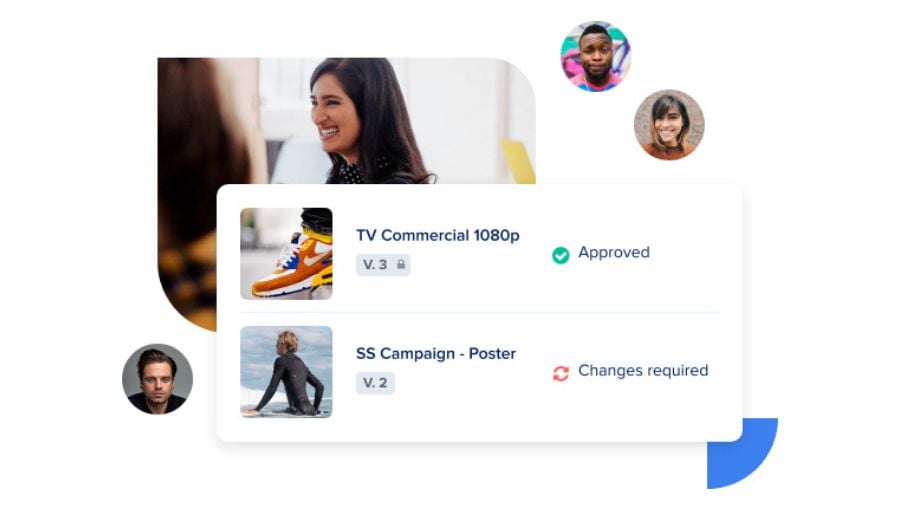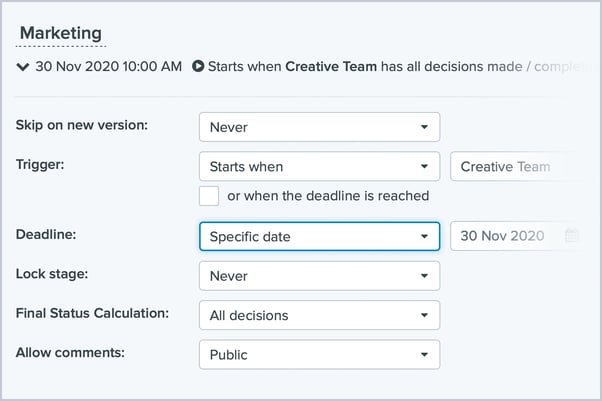The marketing approval process might not sound glamorous, but it’s vital to creative agencies and brands when creating any type of marketing asset. Streamlining your marketing content approval process is essential to ensure your campaigns hit the market on time and with the desired impact.
The process of approving marketing assets can cover almost every aspect of marketing production, but it’s often a bottleneck for many agencies and brands.
Our 2020 Creative Production Benchmark Survey revealed that 42% of marketing leaders encountered project delays because internal stakeholders failed to provide feedback and comments on time.
However, despite the need for a more streamlined approval process, marketing leaders still use inefficient methods:
- 48% use email
- 44% use a project management system
- 38% use Google Docs, WeTransfer, or some other file sharing systems
- 21% use PDF annotation tools
These figures underline the fact that there is much room for improvement in the marketing approval process.
So, in this guide, we’ll present you with a six step marketing approval process template to help you overcome the common obstacles faced by marketing teams and highlight how you can streamline the process further with the use of technology.
What we'll cover
Table of contents
- What is a Marketing Approval Process?
- Benefits of a Streamlined Marketing Approval Workflow
- Common Obstacles in the Marketing Approval Process
- 6 Steps for Creating an Efficient Marketing Approval Process
- Use Technology to Streamline Your Marketing Approval Process
- Improve Your Marketing Approval Process
What is a Marketing Approval Process?
A marketing approval process evaluates all the creative and marketing assets from ideation to campaign launch and facilitates coordination and collaboration between the various stakeholders.
While the methods, activities, and people involved in creating and approving marketing assets are unique to each organization, the marketing approval process involves coordinating content creators (writers, graphic designers, videographers, digital marketers), approvers (marketing managers, creative directors), and external stakeholders (clients, brand partners, suppliers).
Moreover, as marketing assets move through the various review stages, the marketing approval process compiles a complete history of modifications and sign-offs, including all of the feedback, comments, change requests, versions, and actions taken around content creation.
Benefits of a Streamlined Marketing Approval Workflow
Implementing a marketing approval process not only saves a great deal of back and forth during content creation but also improves collaboration and consistency among stakeholders. By streamlining your marketing approval workflow, everyone from your Design, Copy, Marketing, Client Services, and Compliance teams can easily see the real-time progress of the content creation process and make better-informed decisions and quicker approvals.
A streamlined marketing approval workflow can significantly:
- Reduce collaboration and communication delays around change requests.
- Eliminate the time spent locating stakeholders and updating the team about the status of projects.
- Enhance client project management by meeting or exceeding SLAs.
- Accelerate project delivery timelines.
- Save time and effort managing, sharing, and tracking the latest versions of assets.
- Maintain standard project management procedures consistently.
Although these best practices may seem like minor adjustments, when applied to all the marketing projects at your organization, the time and cost savings are substantial.
Common Obstacles in the Marketing Approval Process
Change is inevitable during a creative marketing project, whether that’s a new asset request, a revised specification, or a last-minute tweak to a logo. Unfortunately, what seems like a simple change can cause untold problems. Here are some of the common obstacles you’re likely to face in the marketing approval process.
Feedback gets lost in email chains
Despite the abundance of marketing technology, 48% of marketers said they still rely on email for the approval process. While email has its place, it’s not the right tool to use for marketing approvals.
Here’s why:
- Email chains lack transparency and create delays in marketing campaigns.
- It’s easy to exclude people when you reply or forward emails so that half the team remains in the dark about the current status.
- Feedback in emails is not tied to the creative asset in question, so it’s hard to take action.
- Feedback from some parties might come later in the email chain after things have moved on, so it becomes irrelevant and confusing.
Approval process becomes decentralized
One of the biggest obstacles in the marketing approval process is ensuring everyone has access to the assets and can collaborate effectively. Unfortunately, most approval systems are decentralized, so marketing teams waste precious time manipulating files to get them in the right place for approval.
For instance, while creating your campaign assets, you might have your graphic designers using Adobe Illustrator, your copywriters using Google Docs, and your video team editing in Premiere Pro.
Now, when it comes to approving assets, you have to arrange access to different systems. Even then, the approver can only see one part of the overall campaign, so it’s challenging to evaluate the asset and provide feedback. Maybe the video needs rework, but the copy is okay. How do you join the dots?
When feedback is decentralized, the marketing approval process falls into chaos.
Lack of status tracking
Even if your team uses shared drives and team chat, there’s no transparent status tracking of your marketing assets, which leads to the following issues:
- You can’t see who approved an asset, so you’re open to surprise feedback or changes that can derail the scope and schedule of a marketing campaign.
- You can’t track markups, annotations, and file versions, so your creators and approvers are unsure about current or approved versions.
- You have two disparate systems – one for managing project tasks and deadlines, and another for storing and sharing attachments, emails, comments, and version files.
- Your team spends as much time chasing feedback and confirming approvals as creating and improving marketing assets.
Versioning is not controlled
Without version control, you can run into all kinds of trouble.
For starters, people don't know which version is the latest one and often provide feedback on older versions. Or, your colleague starts modifying a file they believe to be the latest version, only to find out hours later that they’re using an old version.
It’s immensely frustrating for everyone involved, wastes countless hours, and delays projects significantly.
You can avoid confusion and save time by keeping every version in one central location and locking the old versions so everyone's working on the latest one - no more multiple file versions!
For instance, Ziflow maintains all comments, replies, and attachments for review or auditing for the original and each new version added to your project. As soon as a new version is created, the old one is locked to ensure everyone's working on the latest one.
Internal and external reviewers are disconnected
If your marketing workflow involves internal and external stakeholders, you’ll likely encounter another obstacle during the approval process.
Often, there is a disconnect between internal and external teams at different stages in the workflow, leading to people reviewing the wrong assets or the wrong stakeholders entering the review process at the wrong time.
The disconnect can occur through lost or broken communication or inadequate file access.
Ziflow makes it easy to track review progress from a single custom dashboard, so everyone always knows who’s doing what next. Internal and external teams can see what stage a review is in and what actions reviewers still need to take.
6 Steps for Creating an Efficient Marketing Approval Process
You can create an efficient marketing approval process by following these six steps:
1. Identify stakeholders
The first step is to identify both internal and external stakeholders.
Stakeholders are the people responsible for executing specific steps in the marketing approval process. For example, in the content creation workflow, the stakeholders might be a copywriter, a graphic designer, an editor, and a marketer.
Stakeholders can come from different teams and departments. For example, the approval process might involve people from the marketing, product, HR, and legal teams to ensure assets are compliant. Furthermore, some of these people might come from external agencies.
However, it’s essential that each person knows their role and when they are expected to contribute.
2. Map out review stages
The next step is to map out the review stages in your marketing approval process. And to make things crystal clear, you should separate your internal review stages from the external ones. For example, your internal creative team can collaborate efficiently in the early stages before clients or high-level stakeholders get involved in the later stages.
Ask the following questions to determine who you should involve at each review stage:
- What project or approval details do you want to spot quickly?
- What will help your creative team to work more efficiently?
- What type of content should be segmented?
- Which comments or versions should be internal, external, or both?
The goal is to ensure internal and external reviewers receive content at the correct time so that they can add relevant comments and feedback based on what other people have contributed.
3. Define brand guidelines
Having identified your stakeholders and mapped out your review stages, you’ll need to define your brand guidelines to ensure consistency throughout the whole process.
Brand guidelines cover both brand voice and design. You may have defined them already in your brand brief and only need to make them available to all the stakeholders.
Brand guidelines typically include:
- Brand colors to adhere to
- Style and accent elements to include
- Any image size requirements to keep for each asset
- Which graphics to use for each piece of content
- How to format headlines and subheadlines
- How to incorporate examples and social proof
- Which grammar standards your team should follow
- How to refer to your products and services
4. Control access at each approval stage
The next step is to ensure you control access at each approval stage. If you involve too many people at each stage, you get conflicting opinions, and the whole approval process becomes cumbersome.
Ask the following questions of each potential reviewer to determine their involvement:
- Are they qualified?
- Are they going to be available at the right time?
- Are they motivated to provide sound feedback quickly and effectively?
- Will they bring a fresh dimension to the process?
If the answer is no to any of these questions, then they’re most likely not required. Only get review and approval from the people that are needed to avoid feedback creep.
5. Set deadlines and automate reminders
Setting deadlines is an essential but often overlooked step in the marketing approval process. The most significant delays are usually waiting for someone to give a review or chasing down a stakeholder to confirm that they were reviewing it.
Setting deadlines helps you:
- Keep your review moving forward and ensure your project doesn't get stuck waiting for one stakeholder to provide reviews.
- Identify bottlenecks if a project gets “stuck” in review tasks.
In Ziflow, you can set relative deadlines for any of your creative review process steps. For example, when a piece of content needs reviewing, set a specific number of days for review sign-off:
Then you can use automated reminders to enforce deadlines and help identify any potential delays or roadblocks before they happen:
6. Keep an audit trail
The final step is to ensure you keep an audit trail of the entire marketing approval process. Audit trails are also essential for any regulatory compliance you may need to adhere to.
Ziflow can do the following:
- Save comments – Who said it, when they said it, and what was attached. You’ll have everything filed and ready for an audit review.
- Store versions – New versions don’t overwrite the old ones. All comments, replies, and attachments are maintained for review or auditing, which is essential to demonstrate marketing compliance.
Use Technology to Streamline Your Marketing Approval Process
As highlighted earlier, some software, like email, is unsuitable for the marketing approval process. But you can use other technology to streamline your creative projects depending on the size and scope of your marketing team.
File storage
You can use file storage systems, such as Google Drive and Amazon S3, to house your creative marketing assets. Whatever software you choose, you need to ensure you have a robust version and naming convention, so everyone uses the latest files.
Project management
Project management software, like Asana, helps you track individual and team-wide tasks and work to time-bound deadlines. It also provides an overall status of work in progress or on hold so that you can chase relevant stakeholders.
One potential downside to project management software is that it’s challenging to find and collaborate on the marketing assets stored elsewhere. Ideally, you need a system that links file storage, sharing, and proofing systems with project management activities.
Content management
You can use content management systems, such as web hosting sites, video hosting sites, or email and marketing systems to house final approved versions of your marketing assets.
Some companies also use an internal CMS to host brand and marketing content for internal access or client use.
It's also possible to automate the file sharing between systems used in the internal review and approval process and your CMS to only approve content used in marketing campaigns.
Content review and approval
You can use content review and approval software, like Ziflow, for the markup, version control, review, and approval of marketing content across all stakeholders and locations without endless email chains.
The upside of online proofing is that you can centralize feedback and approvals across many different content types, including images, videos, audio, websites, and PDFs, so that creative teams can collaborate on everything seamlessly.
Aside from real-time feedback and collaboration, Ziflow also automates tasks and reminders and allows you to track review progress and improve team performance with insights and analytics features.
Improve Your Marketing Approval Process
Having an efficient process and system for reviewing and approving marketing assets is incredibly beneficial for marketing teams. It removes common obstacles and streamlines the marketing approval workflow so that you can:
- Reduce collaboration and communication delays.
- Eliminate the time spent locating and chasing stakeholders.
- Reduce the time spent updating the team on the project status.
- Accelerate marketing project delivery timelines.
- Save time and effort managing, sharing, and tracking the latest versions of assets.
If you want to improve your marketing approval process with a modern online proofing system, get started with Ziflow for free today.






